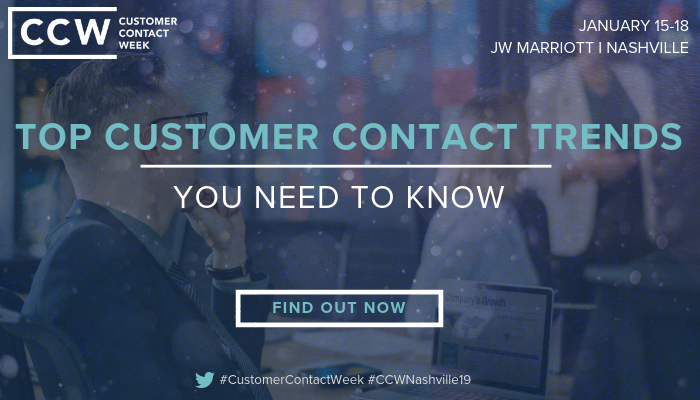It’s that time of year. We’re all making predictions and tracking trends in customer experience. What will happen in 2019? Which trends will matter? Which will fade away? One thing we predict will not change for a long time is the need to reduce customer effort.
CCW’s latest report, 2019 Trends, highlighted many great trends, but one of them really caught my eye:
“Reducing customer effort is the #1 CX Priority in 2018, and organizations believe customer feedback, agent training and digital engagement are the keys to achieving that objective. Reducing efforts will only begin when organizations understand customer journeys and personas.”

Customer Contact Week’s report is filled with great tips and facts to help you create better experiences. Get your copy here!
We’ve been talking about ways to reduce customer effort for a while now. And yet it continues to be an elusive and difficult to achieve goal. Understanding the customer journey is a key part of it. With the rise in journey mapping popularity, it’s easy to think we’re doing that! But there are serious limitations to our understanding today, and I think I have a few ideas why.
In fact, they aren’t really a project at all. Viewing a journey map as a static and once-in-a-while tool leads to complacency around really understanding the rapid changes happening in today’s marketplace.
Customers are expecting more, even if the experience you provide is not changing. Using the journey map to help identify the hot spots on a constant basis is how the best organizations stay one step ahead.

Listen here for great tips on human-centric service design.
If employees are only asked to think about the customer in times of crisis or quarterly results discussions, they will stop thinking about the customer!
Leaders need to reinforce a focus on the customer through constant communication and tying the results back to that focus. Employees should feel compelled to include the customer impact in each decision. They need to understand how their daily work connects back to the customer journey. Leaders need to make sure the focus on the customer comes from the top.
Reducing customer effort should never be about just becoming better than the not-so-great way of doing things. Instead of asking, “how can we reduce hold time at our contact centers,” ask “how can a customer contact someone directly on the first attempt?”
Think differently about what effort really means to customers.
That five-minute wait time might be an improvement over the 25-minute wait time of last year, but the real goal should be eliminating a wait altogether. Get specific about why. It’s not just the time, it’s the fact that our customer had to call in because he or she had a problem. That’s unnecessary effort for the customer. In fact, calling in at all is effort we should aim to eliminate!
Do you really know your customer’s journey well enough to reduce customer effort and eliminate some of the steps it takes to do business with your organization? It’s a big question with lots of questions underneath that one.
 Jeannie is an award-winning customer experience expert, international keynote speaker, and sought-after business coach who is trailblazing the movement from “Reactive Customer Service” to “Proactive Customer and Employee Experience.” More than 500,000 people have learned from her CX courses on LinkedIn Learning, and her insights have been featured in Forbes, The Chicago Tribune, The Wall Street Journal and NPR.
Get Jeannie’s insights in your inbox each week by subscribing to The Weekly Win and follow her on LinkedIn, Instagram and YouTube.
Jeannie is an award-winning customer experience expert, international keynote speaker, and sought-after business coach who is trailblazing the movement from “Reactive Customer Service” to “Proactive Customer and Employee Experience.” More than 500,000 people have learned from her CX courses on LinkedIn Learning, and her insights have been featured in Forbes, The Chicago Tribune, The Wall Street Journal and NPR.
Get Jeannie’s insights in your inbox each week by subscribing to The Weekly Win and follow her on LinkedIn, Instagram and YouTube.